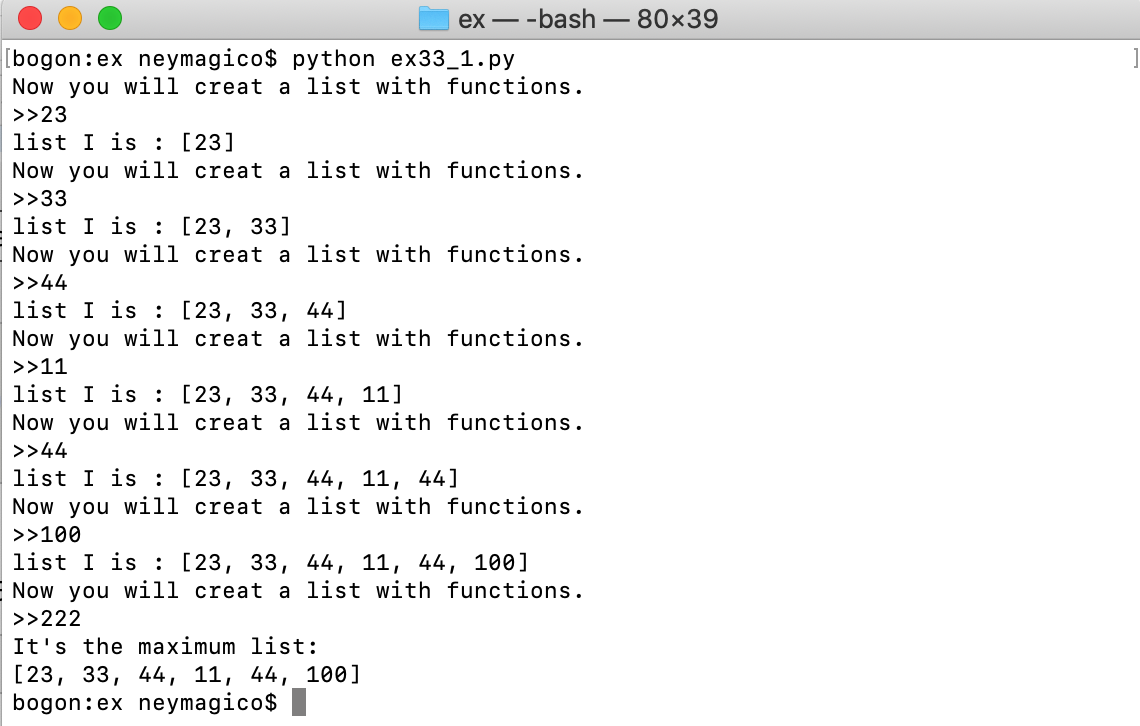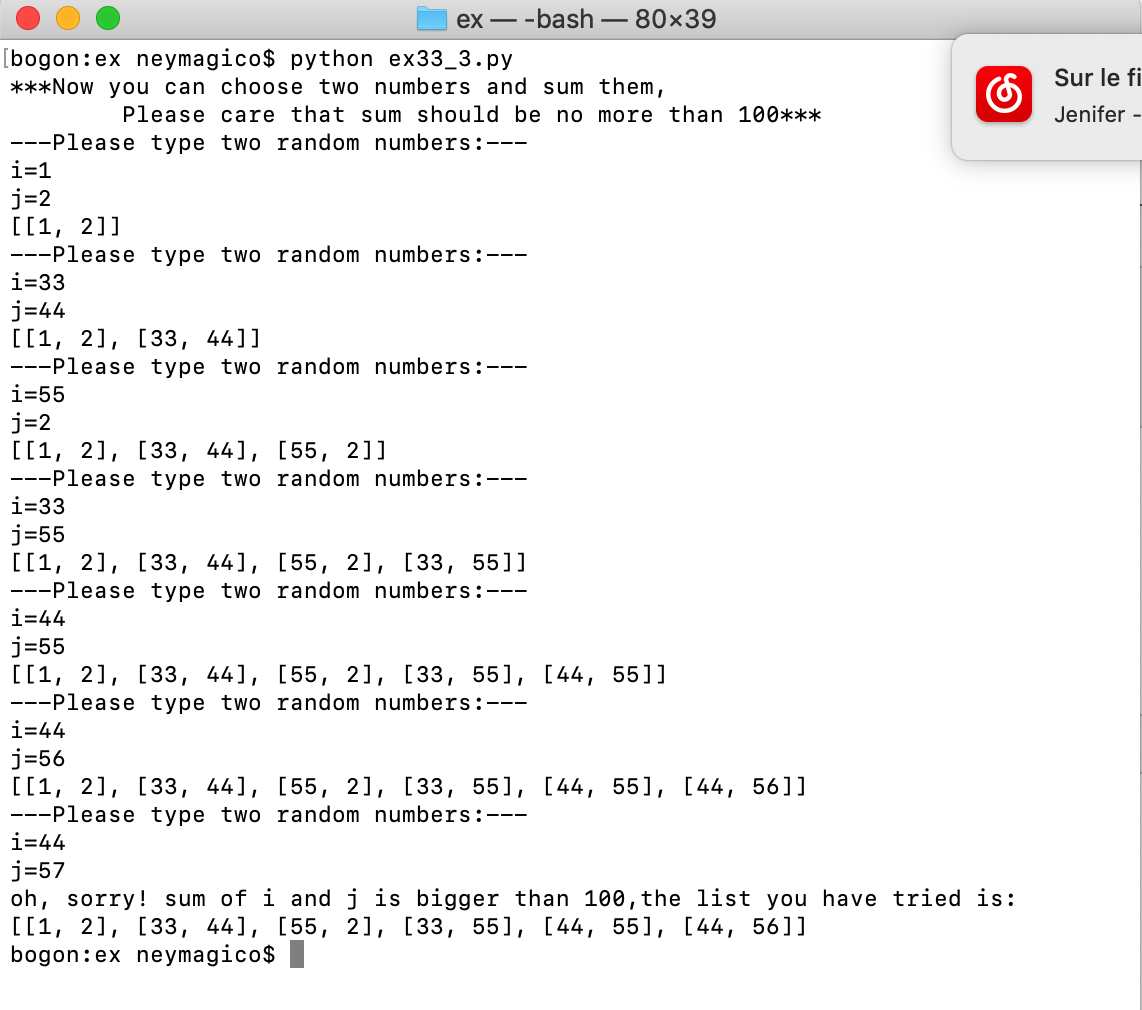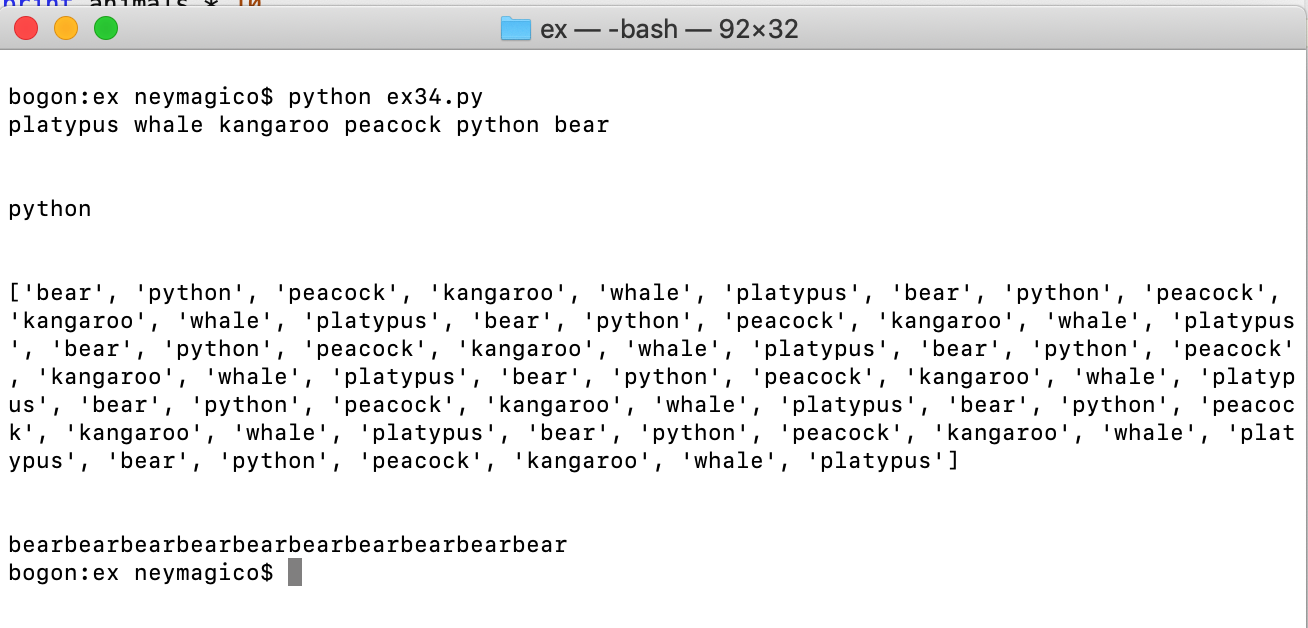第十章预告:逻辑关系、布尔表达式、if/elif/else语句、循环for语句、while语句、列表及其相关
这一章,最关键的是分清True和False。注意这两个单词的形式必须是:首字母大写,其余小写,因为只有这样,Python才会辨别。
---------------------------------<习题27&28:逻辑关系和布尔表达式>------------------------------
这两个习题,讲得就是我们常说的“与或非”,通过一系列的运算,得到一个True或者False。具体内容大家请参考Zed.A.Shaw著《“笨办法”学Python》的习题27和习题28。
值得注意的是:如果在and 和 or 语句两侧,不是True或False,而是数值或字符串,Python会返回什么样的结果呢?
下面是我在python里尝试的结果:

其实上面截图里的命令行,不是布尔表达式,而是简单的and和or语句(两侧都不是True或false)不知道大家有没有总结出规律:
1,or 语句,Python返回第一个操作对象;但是如果or语句两侧有一个False,Python返回另外一个“非False”的对象,这个语句属于布尔表达式
2,and语句,Python返回第二个操作对象;但是如果and语句两侧有一个False,Python只返回False,这个语句属于布尔表达式
上面的结果,于Zed.A.Shaw在习题28的第一个常见问题的解答有部分冲突,感兴趣的朋友可以自己研究一下!
--------------------------------<习题29&30&31:if/else/elif语句及其应用>-----------------------------
稍微接触过编程的同学,应该都知道if语句,这是三个习题都比较容易阅读和理解,我就不多介绍,只在这贴出代码。

1 #-*-coding:utf-8-*- 2 # 简单的if语句 3 people = 3 4 cats = 2 5 dogs = 5 6 7 8 if people < cats: #此处的冒号,是告诉python接下来要创建一个新的代码块 9 print "Not many cats! The world is doomed!" 10 11 if people > cats: 12 print "Not many cats! The world is saved!" 13 14 if people < dogs: 15 print "The world is drooled on!" 16 17 if people > dogs: 18 print "The world is dry!" 19 20 21 dogs += 5 22 23 if people >= dogs: 24 print "People are greater than or equal to dogs." 25 26 if people <= dogs: 27 print "People are less than or equal to dogs." 28 29 30 if people == dogs: 31 print "People are dogs." 32

1 #-*-coding:utf-8-*- 2 # if/else语句,输入值已经预定OK了 3 people = 30 4 cars = 40 5 buses = 15 6 7 8 if cars > people: 9 print "We should take the cars." 10 elif cars <people: 11 print "We sholud not take the cars." 12 else: 13 print "We can't decide." 14 15 if buses > cars: 16 print "That's too many buses." 17 elif buses < cars: 18 print "Maybe we could take the buses." 19 elif buses < people: #python只会运行它遇到的是True的第一个elif语句,此处的为第二个,所有python并不运行 20 print "ss" 21 else: 22 print "We still can't decide." 23 24 if people > buses: 25 print "Alright, let's just take the buses" 26 else: 27 print "Fine, let's stay home then."

1 #-*-coding:utf-8-*- 2 # if/else语句:输入值是用户自己输入,即用户自己做出决定 3 print "You enter a dark room with two doors. Do you go through door #1 or door #2?" 4 5 door = raw_input(">") 6 7 if door =="1": 8 print "***There's a giant bear here eating a cheese cake. What do you do?***" 9 print "(1) Take the cake." 10 print "(2) Scream at the bear." 11 12 bear = raw_input(">") 13 14 if bear == "1": 15 print "The bear eats your face off. Good job!" 16 elif bear == "2": 17 print "The bear eats your legs off. Good job!" 18 else: 19 print "Well, doing %s is probably better. Bear runs away."% bear 20 21 elif door =="2": 22 print "***You stare into the endless abyss at Cthulhu's retina***" 23 print "(1) Blueberries." 24 print "(2) Yellow jacket clothespins." 25 print "(3) Understanding revolvers yelling melodies." 26 27 insanity = raw_input(">") 28 29 if insanity == "1" or insanity =="2": 30 print "Your body survives powered by a mind of jello. Good job!" 31 else: 32 print "The insanity rots your eyes into a pool of muck. Good job!" 33 34 else: 35 print "You stumble around and fall on a knife and die. Good job!" 36
需要强调一下elif语句:它相当于if语句的扩展,可以存在多个elif语句,而且如果它们都是True,python只会运行它遇到的第一个True的if或elif语句。可参考ex30.py
关于if,elif,else语句的运行顺序和原理,我做了一个代码如下:

1 #-*-coding:utf-8-*- 2 # 区别if/else 和if/elif/else的区别 3 prompt = "<" 4 a=int(raw_input(prompt)) #此处必须将a强制转换成数字型字符,不然下方只运行else命令 5 b=int(raw_input(prompt)) 6 7 8 print "This is if and else" 9 if a < 7: 10 print "A" 11 if a < 8: 12 print "B" 13 if a < 9: 14 print "C" 15 if b <12: 16 print "D" 17 else: 18 print "X" 19 20 print "This is if and elif and else" 21 if a < 7: 22 print "E" 23 elif a < 8: 24 print "F" 25 elif a < 9: 26 print "G" 27 elif b < 12: 28 print "H" 29 else: 30 print "Y"
-----------------------------------<习题32:for循环语句和列表list>--------------------------------
从这个习题开始,写的代码都稍微有些复杂了,特别是牵扯到列表list。不要紧张,换种说法:现在你应该有能力写出更有趣的程序啦!
单词for在英语中的解释,也有“因为、由于”的意思,那么for循环语句就可以这么解释:由于xxxxx,而xxxxx。
列表list:这是一个很重要的东西,希望大家给予足够的尊重!
列表的形式: list = ['brown', 'blond', 'red'] 表示该列表被赋值给一个叫list的变量,该列表含有三个元素,分别是'brown', 'blond', 'red',如果需要调用这三个元素,可以用list[0], list[1], list[2]。 其实列表的最后一个元素,也可以用list[-1]来调用,记住第一个元素是list[0]。
列表的元素可以是:数值、字符串、甚至也可以是列表
ex32.py:简单介绍列表list是什么; 如何用for循环打印列表的元素;如何append在空列表里添加元素,代码如下:

1 #-*-coding:utf-8-*- 2 # for循环和列表:打印列表,创建列表,在列表中增加数字 3 the_count = [1, 2, 3, 4, 5] 4 fruits = ['apples', 'oranges', 'pears', 'apricots'] 5 change = [1, 'pennies', 2, 'dimes', 3, 'quarters'] 6 7 # this first kind of for~loop goes through a list 8 for number in the_count: 9 print "This is count %d" %number 10 11 # same as above 12 for fruit in fruits: 13 print "A fruit of type:%s" % fruit 14 15 # also we can go through mixed lists too 16 # notice we have to use %r since we don't know what's in it 17 for i in change: 18 print "I got %r" % i 19 20 # we can also build lists, first start with an empty one 21 elements = [] 22 23 # then use the range function to do 0 to 5 counts 24 for i in range(0, 6): #range 表示一个整数的范围,例如range(i,j)指的是范围(i, i+1, i+2,...,j-1) 25 print "Adding %d to the list." %i 26 #append is a function that lists understand 27 elements.append(i) 28 29 # now we can print them out too 30 for i in elements: 31 print "Element was:%d" %i 32 33 print "the complete list elements is :", elements
终端运行结果如下:

ex32_1.py: 如何在一个非空的列表中增加特定的元素; 一次性打印列表全部元素的方式

1 #-*-coding:utf-8-*- 2 # 各种创建列表的方法1: 在数值列表中增加其它数字 3 4 I = [1, 2, 3, 4, 5] 5 6 for i in range(6,100): 7 I.append(i) 8 9 list = I #重新将列表的值赋予一个变量,然后print这个变量,便可以打印出列表了 10 print list # 一次性将列表打印出来
终端运行结果如下:

ex32_3.py: 列表中增加元素/列表/字符串,代码如下:

1 #-*-coding:utf-8-*- 2 # 各种创建列表的方法1: 在数值列表中增加另一个数字/字符串列表 3 4 A = [] 5 I = [1, 2, 3, 4, 5] 6 L = [6,7,8] 7 K = [9,10,11] 8 H = ['hello', 'my', 'friend'] 9 10 #方法1:将两个列表的元素放到一个列表当中,新列表的元素个数和等于两个原始列表的元素个数总和 11 for i in L: 12 I.append(i) #这种方式,得到的I是[1,2,3,4,5,6,7,8] 13 14 #I.append(I) #这种方式,得到的I是[1,2,3,4,5,[6,7,8],[6,7,8],[6,7,8]] 15 16 list = I #重新将列表的值赋予一个变量,然后print这个变量,便可以打印出列表了, 17 # 注意:如果下面再次引用到序列I,则I的值已经变成 [1,2,3,4,5,6,7,8],不再是原始数据了 18 print "list is:",list 19 20 #方法2:将两个列表的元素放到一个列表当中,新列表的元素个数和等于两个原始列表的元素个数总和 21 X = L + K 22 list2 = X 23 print "list2 is:",list2 #得到[6, 7, 8, 9, 10, 11] 24 25 #将两个列表作为两个元素,放到一个列表当中 26 list3 = L 27 list4 = K 28 list5 = [list3, list4] 29 print "list5 is:", list5 # 得到[[6, 7, 8], [9, 10, 11]] 30 31 # 如何创建一个等长等宽,而且每列的值均相等的列表(例如下方的3*3) 32 for i in L: 33 A.append(L) 34 list6 = A 35 print "list6 is:",list6 #这种方式,得到的I是[[6,7,8],[6,7,8],[6,7,8]] 36 37 # 在数值列表中增加字符串,是一样的操作 38 for i in H: 39 L.append(i) 40 list7 = L 41 print "list7 is:", list7
终端运行结果如下:

--------------------------------------<习题33:while循环语句>-----------------------------------
while循环语句:它会一直执行它下面的代码块,直到while后面的布尔表达式为False时才会停下来。
注意:这个循环语句 “while 2”是一个dead loop,因为这里的2就相当于一直是True,所以这个循环语句会一直执行,除非你编码强制让它停止。
while循环语句和for循环语句的区别是:while循环是用布尔表达式的结果True 或者 False来决定是否循环,一般是用在死循环中;而for循环一般是用“遍历”来做循环的条件,例如for i in list: 意思是只要变量i在list当中,就执行这个for循环块,直到list里面的所有的元素都循环一遍就结束。
ex33.py:用while循环语句创建一个列表,一般情况下不用while语句,因为它表复杂。代码如下:

1 #-*-coding:utf-8-*- 2 # While 循环:一步一步地往列表里增加元素 3 4 i = 0 5 numbers = [] 6 7 while i < 6: #此处的变量i不需要重新定义,因为在每一个循环当中,都自动定义了 8 print "At the top i is %d" %i 9 numbers.append(i) 10 11 i = i + 1 12 print "Numbers now:", numbers 13 print "At the bottom i is %d" %i 14 15 16 print "The numbers:", numbers # 输出结果为 The numbers: [0, 1, 2, 3, 4, 5]
终端运行结果如下:

ex33_1.py :用函数来达到while或for循环的目的:新建整数列表,元素的列表手动输入。你可以在代码的解释中看到循环的原理。代码如下:

1 #-*-coding:utf-8-*- 2 # 自制用函数达到while或for循环的目的:整数列表 3 4 I = [] 5 6 def creat_list(): 7 print "Now you will creat a list with functions." 8 i = int(raw_input(">>")) # 9 if i <= 100: 10 I.append(i) 11 print "list I is :", I 12 creat_list() # 该处是函数循环的关键 13 elif i >= 100: #该处是停止函数循环的关键 14 print "It's the maximum list:" 15 print I # 返回最终版的列表 16 17 18 creat_list()
终端运行结果如下:我随便输入的几个数值

ex33_2.py:这是一个很有意思的代码,“爱情就是毒药”,如果你“love”,你就“die”。 它也是用手动输入的形式,利用函数来代替while或for循环创建列表,列表的元素可以是字符串,也可以是数值。代码如下:

1 #-*-coding:utf-8-*- 2 # 自制用函数达到while或for循环的目的:字符列表 3 4 I = [] 5 6 print "***In this function, you can type all the words except for 'love'***" 7 def creat_list(): 8 print "---Now you can try some words :---" 9 a = raw_input('>>>') 10 i = a 11 12 if 'love' in i: #该处是停止函数循环的关键 13 print "***oh, shit! I am poisoned by LOVE***" 14 15 else: # 该处是函数循环的关键 16 I.append(i) 17 print I 18 print "***I am well without forbidden word!***" 19 creat_list() 20 21 22 creat_list() 23 24 25
终端运行结果如下:

ex33_3.py: 也是用手动输入的形式,利用函数来代替while或for循环创建“二维”列表,即列表的元素为“两个元素的小列表”。代码如下:

1 #-*-coding:utf-8-*- 2 # 自制用函数达到while或for循环的目的:二维列表 3 4 I = [] 5 print "***Now you can choose two numbers and sum them, " 6 print " Please care that sum should be no more than 100***" 7 8 def creat_list(): 9 print "---Please type two random numbers:---" 10 i = int(raw_input('i=')) 11 j = int(raw_input('j=')) 12 if i + j <= 100: 13 I.append([i, j]) 14 print I 15 creat_list() # 该处是函数循环的关键 16 else: #该处是停止函数循环的关键 17 print "oh, sorry! sum of i and j is bigger than 100,the list you have tried is:" 18 print I # 返回最终版的列表 19 20 creat_list() 21 22 23
终端运行结果如下:

----------------------------------------<习题34:访问列表元素>-------------------------------
列表的元素的位置,牵扯到基数cardinal number和序数ordinal number的区别。例如list['a', 'b', 'c', 'd', 'e', 'f']中的元素a的序数为1,但基数为0,b的序数为2,技术为1。具体的实例见ex34.py:

1 #-*-coding:utf-8-*- 2 # 访问列表的某个元素元素,序数、基数的转换 3 4 animals = ['bear', 'python', 'peacock', 'kangaroo', 'whale', 'platypus'] 5 6 print animals[5], animals[4],animals[3],animals[2],animals[1],animals[0] 7 print " " 8 print animals[1] 9 print " " 10 print animals * 10 11 print " " 12 print animals[0 ] * 10
终端运行结果如下:

第十一章预告:分支和函数、设计和调试、列表的特殊操作
